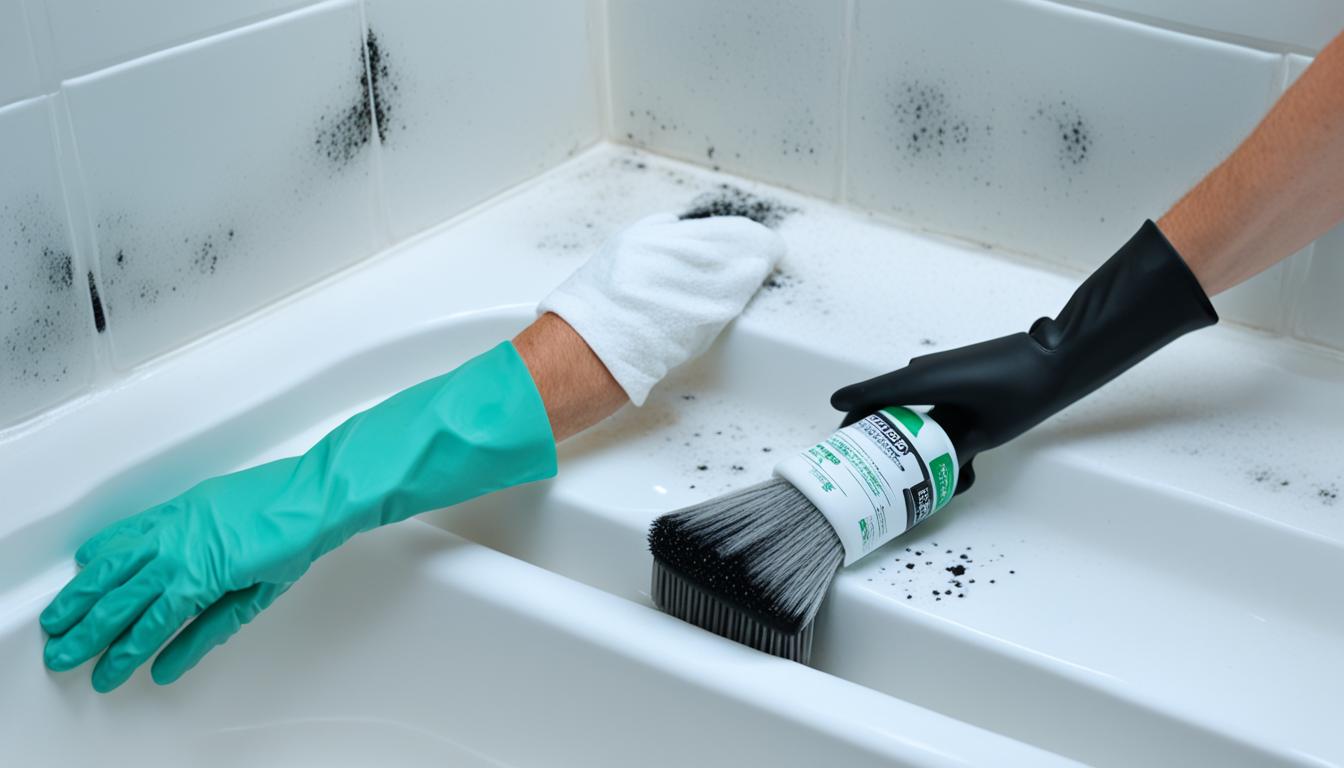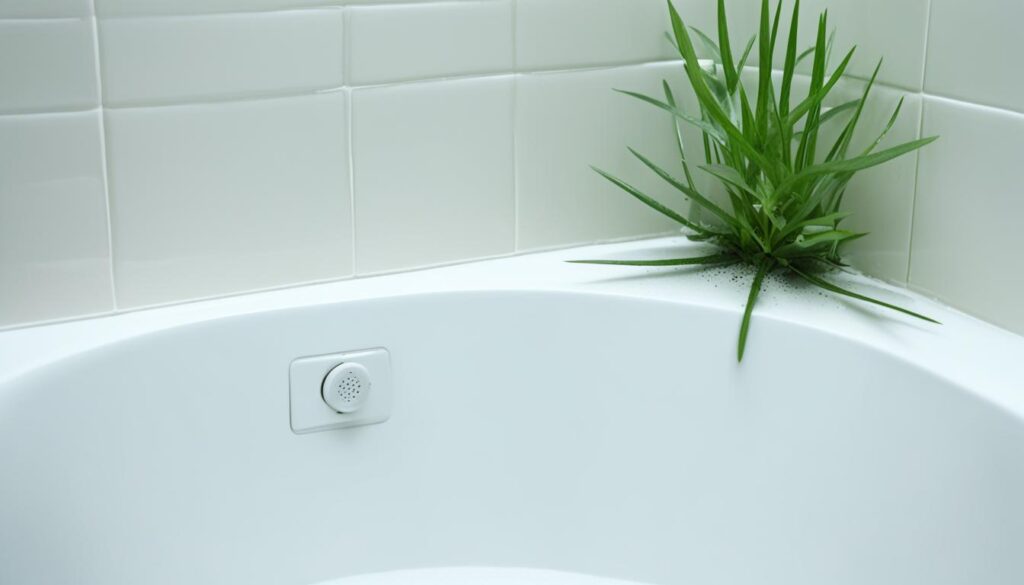
Mold Removal Guide for Bathtubs: Easy Fixes
Welcome to our comprehensive mold removal guide for bathtubs. If you’re dealing with mold around your tub, it’s essential to address this issue promptly to maintain a clean and healthy bathroom environment. In this section, we will provide you with an easy-to-follow step-by-step guide on how to fix mold around your tub effectively. By following these simple fixes, you’ll be able to combat bathroom mold and ensure a safe space for you and your family.
Key Takeaways:
- Removing mold around bathtubs is critical for a clean and safe bathroom environment.
- By following our step-by-step guide, you can easily fix mold around your tub.
- Addressing mold issues promptly helps prevent further mold growth and potential health hazards.
- Regular cleaning and maintenance can help prevent mold buildup in the first place.
- Remember to wear protective gear when dealing with mold and always ensure proper ventilation in your bathroom.
Preventing Mold Growth in Bathrooms
When it comes to maintaining a clean and healthy bathroom environment, preventing mold growth is crucial. Mold not only poses health risks but also damages the aesthetic appeal of your bathroom, particularly around the bathtub area. By implementing effective preventive measures, you can minimize the chances of mold and mildew buildup, ensuring a healthier living space for you and your family.
1. Proper Ventilation
One of the key strategies for mold prevention in bathrooms is ensuring proper ventilation. Moisture is one of the main factors that contribute to mold growth. Allowing fresh air to circulate can help reduce humidity levels and prevent mold from thriving.

2. Regular Cleaning and Maintenance
Maintaining cleanliness is essential to prevent mold around the bathtub area. Regularly clean the bathtub, walls, and any other surfaces prone to mold growth using mold-specific cleaning products. Eliminating any existing mold and keeping the area dry will go a long way in preventing further mold-related issues.
3. Use Mold-Resistant Products
Selecting mold-resistant products, such as mold-resistant paint, caulk, and grout, can provide an extra layer of protection against mold growth. These products are designed to resist moisture and inhibit mold and mildew formation.
4. Repair Leaks
Identify and repair any leaks in the plumbing system promptly. Leaky pipes or faucets contribute to excessive moisture, creating an ideal environment for mold. Regularly check for any signs of leaks and address them immediately to prevent mold growth.
5. Optimize Air Circulation
In addition to ventilation, improving air circulation can aid in mold prevention. Use fans or dehumidifiers to keep the air moving and remove excess moisture. This will help maintain the overall dryness of the bathroom, reducing the chances of mold and mildew growth.
| Mold Prevention Tips for Bathrooms: |
|---|
| Ensure proper ventilation |
| Regularly clean and maintain the bathtub and surrounding areas |
| Use mold-resistant products |
| Repair any leaks promptly |
| Optimize air circulation with fans or dehumidifiers |
DIY Mold Removal Techniques
If you’ve discovered mold around your bathtub, it’s important to take action promptly to prevent further damage and potential health risks. While professional help is always an option, there are several effective DIY mold removal techniques you can implement yourself. These methods will help you eliminate mold effectively and minimize the risk of black mold growth.
1. Vinegar Solution
One of the most popular and affordable methods for mold removal is using a vinegar solution. Mix equal parts white vinegar and water in a spray bottle. Spray the solution onto the affected area and let it sit for at least one hour. Then, scrub the moldy surface with a brush or sponge. Rinse with water and wipe dry. The acidic properties of vinegar help kill mold spores, making it a natural and effective mold removal agent.
2. Hydrogen Peroxide
Hydrogen peroxide is another powerful substance that can eliminate mold around your bathtub. Fill a spray bottle with 3% hydrogen peroxide, which is readily available at most drugstores. Spray the solution onto the moldy area and let it sit for 10-15 minutes. Then, scrub the surface to remove the mold. Rinse with water and wipe dry. Hydrogen peroxide not only kills mold but also helps remove stubborn stains caused by mold growth.
3. Tea Tree Oil
Tea tree oil is a natural antifungal and antibacterial agent that can effectively eliminate mold. Mix 10 drops of tea tree oil with a cup of water in a spray bottle. Shake well and spray the solution onto the moldy surface. Let it sit for a few hours or overnight. Then, scrub the area with a brush and rinse with water. The tea tree oil will not only kill the existing mold but also prevent future mold growth.
4. Baking Soda
Baking soda is a versatile and non-toxic substance that can effectively remove mold from around your bathtub. Create a paste by mixing baking soda with a small amount of water. Apply the paste to the moldy area and let it dry completely. Then, scrub the surface with a brush or sponge. Rinse with water and wipe dry. Baking soda not only kills mold but also absorbs moisture, preventing further mold growth.
5. Bleach
While bleach is a powerful mold-killing agent, it should be used with caution as it can be harmful if not properly diluted. Mix one cup of bleach with one gallon of water in a spray bottle. Spray the solution onto the moldy area and let it sit for 15 minutes. Then, scrub the surface thoroughly. Rinse with water and wipe dry. Be sure to wear protective gloves and ensure proper ventilation when using bleach.
Remember, DIY mold removal techniques are suitable for small, localized areas of mold growth. If you’re dealing with extensive mold or black mold infestations, it’s recommended to seek professional assistance for proper remediation and safe removal.

Conclusion
In conclusion, by following the steps outlined in this guide, you can successfully fix mold around your tub and maintain a mold-free bathroom. The key to preventing mold growth is to address any moisture-related issues promptly and ensure proper ventilation in your bathroom.
Regular cleaning and maintenance, such as wiping dry the bathtub and removing any standing water, can also go a long way in preventing mold buildup. Additionally, using mold-resistant products, such as mold-resistant paint or caulk, can provide an extra layer of protection.
If you find that your mold problem persists or if you require professional assistance, don’t hesitate to contact Fix Mold Miami at 305-465-6653. They are Florida’s highest-rated experts in mold assessments, prevention, and remediation and can help you resolve any mold-related issues with their expertise and experience.




